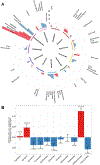Host and gut microbial tryptophan metabolism and type 2 diabetes: an integrative analysis of host genetics, diet, gut microbiome and circulating metabolites in cohort studies
- PMID: 34127525
- PMCID: PMC8697256
- DOI: 10.1136/gutjnl-2021-324053
Host and gut microbial tryptophan metabolism and type 2 diabetes: an integrative analysis of host genetics, diet, gut microbiome and circulating metabolites in cohort studies
Abstract
Objective: Tryptophan can be catabolised to various metabolites through host kynurenine and microbial indole pathways. We aimed to examine relationships of host and microbial tryptophan metabolites with incident type 2 diabetes (T2D), host genetics, diet and gut microbiota.
Method: We analysed associations between circulating levels of 11 tryptophan metabolites and incident T2D in 9180 participants of diverse racial/ethnic backgrounds from five cohorts. We examined host genome-wide variants, dietary intake and gut microbiome associated with these metabolites.
Results: Tryptophan, four kynurenine-pathway metabolites (kynurenine, kynurenate, xanthurenate and quinolinate) and indolelactate were positively associated with T2D risk, while indolepropionate was inversely associated with T2D risk. We identified multiple host genetic variants, dietary factors, gut bacteria and their potential interplay associated with these T2D-relaetd metabolites. Intakes of fibre-rich foods, but not protein/tryptophan-rich foods, were the dietary factors most strongly associated with tryptophan metabolites. The fibre-indolepropionate association was partially explained by indolepropionate-associated gut bacteria, mostly fibre-using Firmicutes. We identified a novel association between a host functional LCT variant (determining lactase persistence) and serum indolepropionate, which might be related to a host gene-diet interaction on gut Bifidobacterium, a probiotic bacterium significantly associated with indolepropionate independent of other fibre-related bacteria. Higher milk intake was associated with higher levels of gut Bifidobacterium and serum indolepropionate only among genetically lactase non-persistent individuals.
Conclusion: Higher milk intake among lactase non-persistent individuals, and higher fibre intake were associated with a favourable profile of circulating tryptophan metabolites for T2D, potentially through the host-microbial cross-talk shifting tryptophan metabolism toward gut microbial indolepropionate production.
Keywords: diabetes mellitus; dietary factors; genetics.
© Author(s) (or their employer(s)) 2022. No commercial re-use. See rights and permissions. Published by BMJ.
Conflict of interest statement
Competing interests: None declared.
Figures






References
-
- Favennec M, Hennart B, Caiazzo R, Leloire A, Yengo L, Verbanck M, et al. The kynurenine pathway is activated in human obesity and shifted toward kynurenine monooxygenase activation. Obesity (Silver Spring) 2015;23:2066–74. - PubMed
-
- Laurans L, Venteclef N, Haddad Y, Chajadine M, Alzaid F, Metghalchi S, et al. Genetic deficiency of indoleamine 2,3-dioxygenase promotes gut microbiota-mediated metabolic health. Nat Med 2018;24:1113–20. - PubMed
Publication types
MeSH terms
Substances
Grants and funding
- R01 DK119268/DK/NIDDK NIH HHS/United States
- P30 DK046200/DK/NIDDK NIH HHS/United States
- P30 DK111022/DK/NIDDK NIH HHS/United States
- P30 ES030285/ES/NIEHS NIH HHS/United States
- U01 DK078616/DK/NIDDK NIH HHS/United States
- R01 HL142003/HL/NHLBI NIH HHS/United States
- K99 DK122128/DK/NIDDK NIH HHS/United States
- R01 HL141824/HL/NHLBI NIH HHS/United States
- R01 HL136266/HL/NHLBI NIH HHS/United States
- P30 DK040561/DK/NIDDK NIH HHS/United States
- R00 DK122128/DK/NIDDK NIH HHS/United States
- R01 DK120870/DK/NIDDK NIH HHS/United States
- K24 HL152440/HL/NHLBI NIH HHS/United States
- R01 DK126698/DK/NIDDK NIH HHS/United States
- R01 MD011389/MD/NIMHD NIH HHS/United States
- P30 DK020541/DK/NIDDK NIH HHS/United States
- R01 HL140976/HL/NHLBI NIH HHS/United States
- R01 HL060712/HL/NHLBI NIH HHS/United States
- UM1 DK078616/DK/NIDDK NIH HHS/United States
- UM1 HG008898/HG/NHGRI NIH HHS/United States
